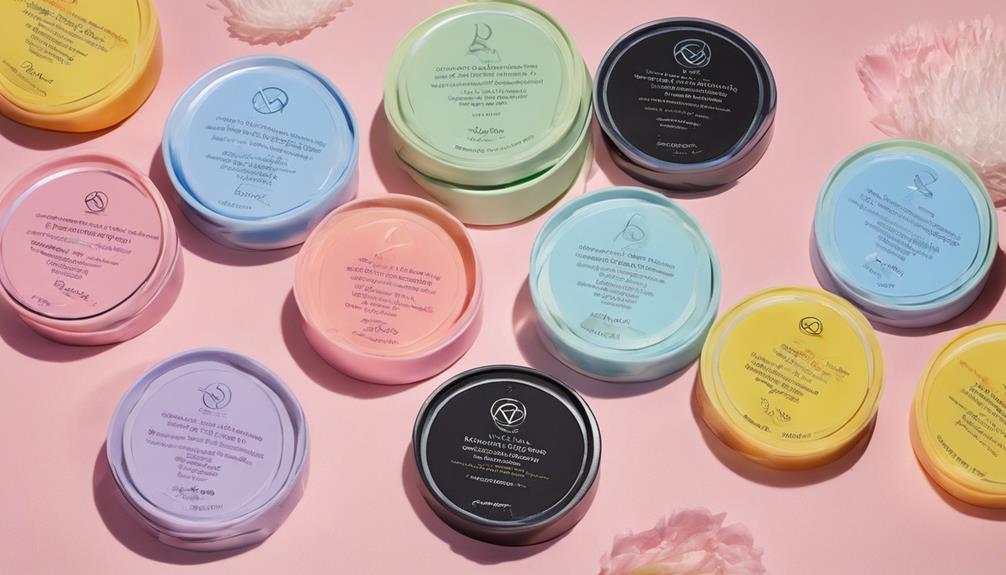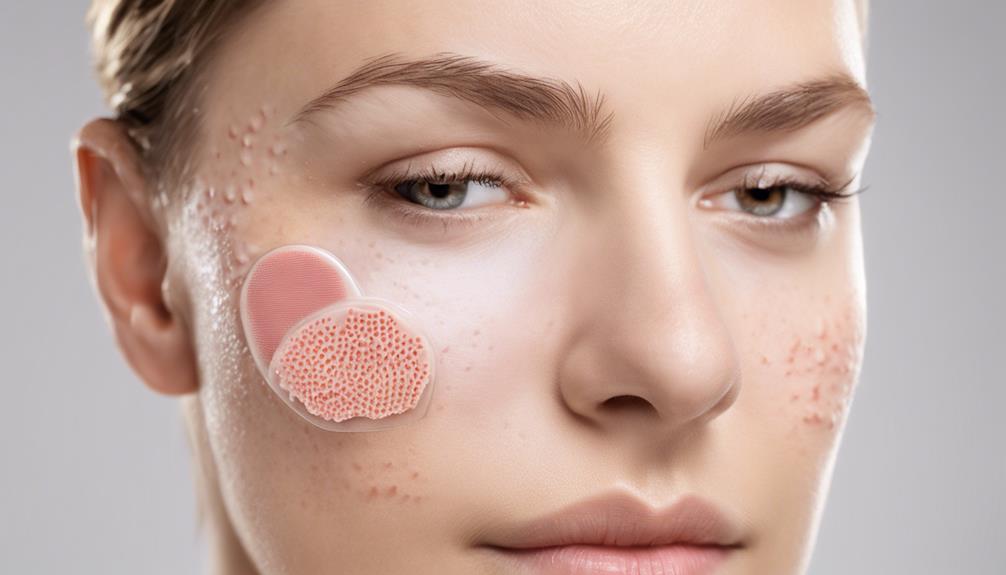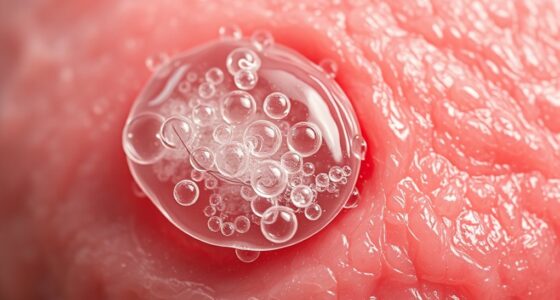Pimple patches are designed to suck out pus, oil, and impurities from your skin, helping to speed up healing and reduce inflammation. When you apply them, they create a protective barrier that prevents further irritation and bacterial growth while absorbing excess fluids. You might be shocked at how much they can draw out! There’s a lot more to discover about their ingredients and effectiveness, so keep going to learn how they can work for you.
Key Takeaways
- Pimple patches absorb excess pus, oil, and sebum from the skin, effectively sucking out impurities from the breakout site.
- They create a moist environment, promoting faster healing while maintaining hydration and preventing scarring.
- The patches also protect against bacteria and external irritants, reducing inflammation and redness at the pimple location.
- Saturated patches turn white, indicating they have effectively absorbed fluids and impurities from the skin.
- While effective for small blemishes, they are not a cure for acne and may not work on deeper cystic acne.
Understanding Hydrocolloid Material in Pimple Patches

Hydrocolloid material is the secret weapon behind effective pimple patches. Originally designed for wound care, this versatile material uses ingredients like gelatin or pectin combined with polyurethane film. It’s specifically engineered to absorb fluids, such as pus and oil, from your skin while forming a protective barrier. This barrier not only keeps external contaminants out but also maintains a moist environment, which is essential for healing and preventing infection. Hydrocolloids are moisture-retentive dressings that aid the wound-healing process by retaining water. Some hydrocolloid patches even boast antibacterial properties to further reduce bacterial growth. With clear designs that fit seamlessly onto your skin, these patches come in various sizes and shapes, making them adaptable for different pimple types. They truly transform how you tackle breakouts.
How Pimple Patches Work: The Healing Process

Pimple patches work by leveraging their unique design to promote healing directly at the site of a breakout. They absorb excess oils and impurities while creating a protective barrier against irritants and bacteria. This helps reduce inflammation, redness, and swelling, speeding up the healing process of your pimples. Pimple patches are particularly effective for blemishes that have come to a head, as they maintain a moist environment that facilitates faster recovery. They’re particularly effective on small, pus-filled bumps or whiteheads, often turning white when saturated with fluids.
Plus, their single-use design prevents the transfer of bacteria, ensuring peak hygiene. With easy application and a deterrent against picking, pimple patches provide a simple, effective solution for managing mild breakouts from the comfort of home.
The Role of Salicylic Acid in Acne Treatment
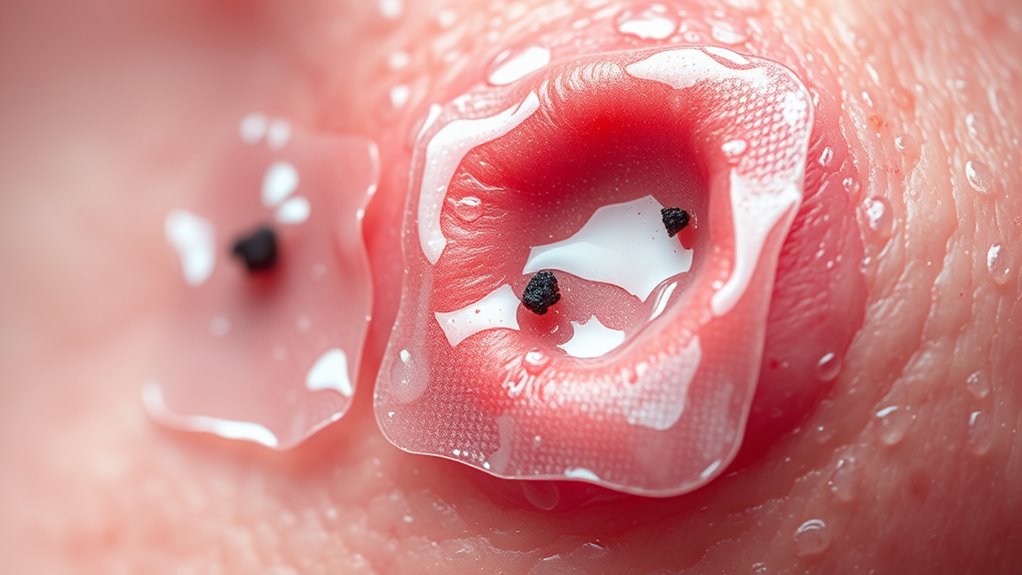
When it comes to acne treatment, salicylic acid stands out as a key ingredient for its multifaceted benefits. It effectively reduces sebum production, helping to keep breakouts at bay.
By unclogging pores and promoting exfoliation, it tackles blackheads and whiteheads while treating comedonal acne. Salicylic acid also boasts anti-inflammatory properties, soothing irritation in acne lesions. Plus, it enhances the penetration of other skincare products, maximizing their effectiveness. Available in concentrations from 0.5% to 2%, it’s commonly recommended for acne vulgaris. Topical treatments are often used in conjunction with salicylic acid to provide comprehensive acne care.
When combined with other treatments, like benzoyl peroxide, its efficacy increases. With these advantages, salicylic acid has become a go-to choice for anyone looking to achieve clearer, healthier skin.
What Pimple Patches Absorb: Fluid and Impurities

A key feature of pimple patches is their ability to absorb excess fluids and impurities from blemishes. These patches, made from hydrocolloid, work by soaking up pus, oil, and sebum directly from your skin. When you apply a patch to a pimple, it creates a protective barrier that keeps out dirt and bacteria while allowing your skin to breathe. As the patch absorbs fluids, it often turns white, signaling effective absorption. Additionally, it helps clear other impurities that contribute to inflammation, promoting a healthier healing environment. By containing these substances, pimple patches not only minimize the risk of infection but also support faster healing, making them a practical choice for targeted acne treatment. They are especially effective for treating individual, surface-level pimples, highlighting their role in a broader skincare routine.
The Benefits of Using Pimple Patches

Using pimple patches offers numerous benefits that can greatly improve your acne treatment routine.
These hydrocolloid patches effectively reduce inflammation by absorbing pus and fluid from pimples, leading to quicker healing. They also prevent you from picking or touching your blemishes, which helps reduce the risk of further infection and scarring. Additionally, these patches provide a protective barrier against bacteria and dirt, further enhancing their effectiveness. The patches can also help mitigate the emotional impact of acne, much like how awareness of narcissistic behaviors can aid in self-protection against emotional distress.
By creating a moist environment, these patches promote healing while minimizing scar tissue formation. Plus, they come in various designs, making them less noticeable during use. Additionally, these patches are made of various materials that enhance their effectiveness in treating blemishes. Research shows that using patches with active ingredients can significantly improve acne treatment outcomes.
You can easily incorporate them into your regimen alongside other skincare products. With active ingredients like salicylic acid and tea tree oil, pimple patches not only target acne but also enhance your skin’s overall health.
Conditions Best Suited for Pimple Patches

Pimple patches work best for specific conditions, particularly those involving pus-filled pimples and mild to moderate acne.
Pimple patches are most effective for pus-filled pimples and mild to moderate acne conditions.
They’re especially effective on surface-level pimples that have formed a head, as the patches absorb fluids and help flatten them. If you’re dealing with whiteheads, look for patches containing salicylic acid, which can unclog pores and promote healing.
These patches also assist in post-popping recovery by protecting the skin and preventing infection. However, they’re less effective for cystic acne, blackheads, and deeper lesions that require more intensive treatments.
If you have oily, normal, or combination skin, these patches can be a helpful addition to your routine, especially if you’re prone to breakouts.
Tips for Maximizing the Effectiveness of Pimple Patches
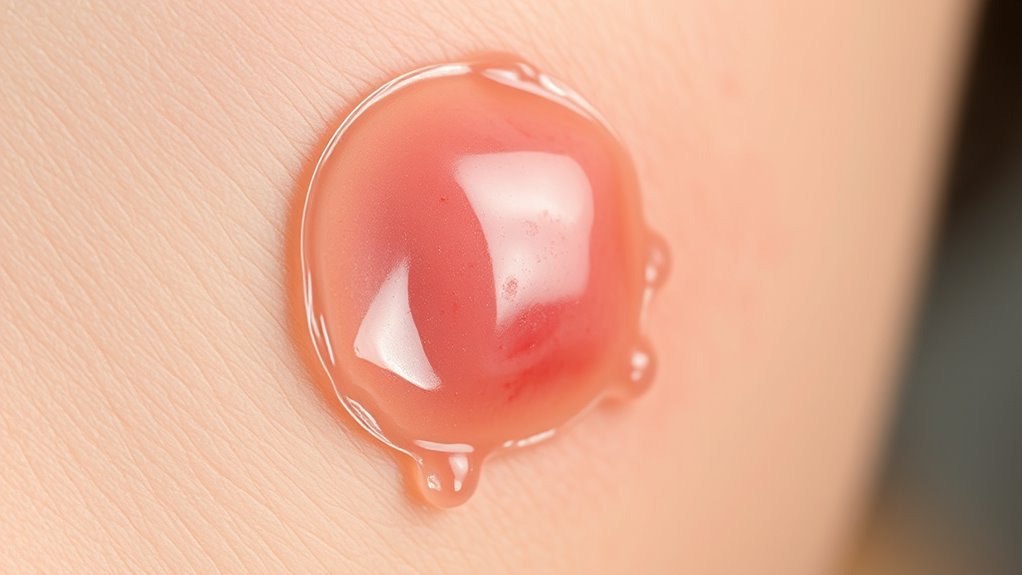
To maximize the effectiveness of pimple patches, start by ensuring your skin is properly prepared. Cleanse your face with a gentle, non-comedogenic cleanser, and make sure your skin is completely dry before applying the patch.
Avoid using heavy moisturizers or makeup, as these can prevent proper adhesion. If you have sensitive skin, opt for hydrocolloid patches without added ingredients. Always perform a patch test if you’re using medicated options to avoid allergic reactions.
Choose the right patch based on your blemish type—hydrocolloid for surface pimples and medicated patches for inflamed ones. When applying, center the patch over the blemish, press gently to avoid air bubbles, and handle the sticky side carefully to keep it clean. This will help ensure that the patches can effectively absorb impurities and promote faster healing, which is particularly beneficial for surface-level breakouts.
Frequently Asked Questions
Can Pimple Patches Be Used on Open Wounds or Cuts?
You can use pimple patches on open wounds or cuts, but proceed with caution.
These hydrocolloid patches help absorb fluid and create a moist healing environment, making them effective for mild wounds. However, they’re not suitable for infected wounds.
Keep in mind that the adhesive may irritate sensitive skin, so always test a small area first.
For serious injuries or infections, it’s best to seek professional medical advice.
How Long Should I Leave a Pimple Patch On?
You should leave a pimple patch on for about 4 to 8 hours for ideal results.
If you want to boost its effectiveness, try wearing it overnight for 8 to 12 hours.
For stubborn blemishes, some patches can be left on for up to 24 hours.
Just keep an eye out for a white spot forming, which indicates it’s time to remove the patch and let it work its magic.
Are Pimple Patches Safe for All Skin Types?
You might be surprised to learn that pimple patches are generally safe for all skin types, including sensitive skin.
They work wonders by reducing inflammation and preventing you from picking at pimples.
However, if you’ve got sensitive skin, you should patch test first, since ingredients like salicylic acid can irritate.
Just remember, avoid using them on open wounds, as this could trap bacteria and hinder healing.
Happy patching!
Can I Wear Makeup Over a Pimple Patch?
Yes, you can wear makeup over a pimple patch!
Start by cleansing and drying your skin, then apply a compatible patch.
When it’s time for makeup, use a gentle touch to avoid dislodging the patch.
Opt for thin layers of foundation and concealer to create a smooth finish.
This way, you can conceal your blemishes while keeping your skin protected from irritation and preventing the urge to pick at them.
How Often Can I Use Pimple Patches in a Week?
You could be using pimple patches like a skincare superhero!
In a week, you can use them daily if needed, but don’t overdo it—your skin might rebel. Aim to apply them right when a breakout appears for the ultimate impact.
Each patch works its magic for 6 to 12 hours, so replace them as needed.
Just remember, balance is key, especially if your skin’s feeling sensitive or dry. Keep your routine steady!
Conclusion
In the battle against breakouts, pimple patches are like tiny warriors, fighting off impurities and promoting healing right on your skin. By understanding how they work and what they absorb, you can harness their full potential. Whether you’re dealing with a pesky pimple or a more stubborn spot, these patches can be your secret weapon. So, next time you reach for one, remember—you’re not just covering up; you’re giving your skin the care it deserves.


